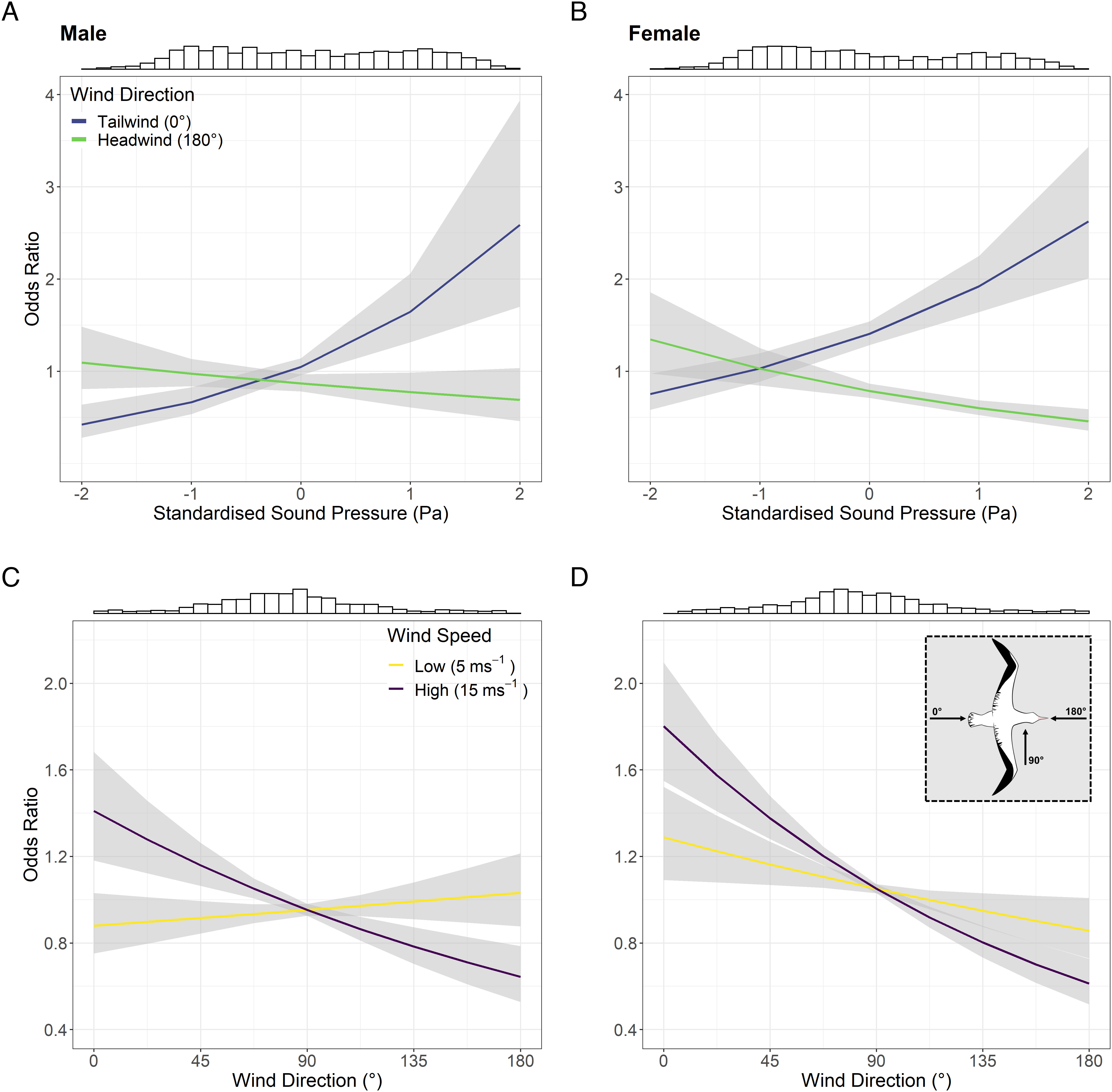信天翁的运动表明其对海上次声信号的敏感性
作者:Natasha Gillieshttps://orcid.org/0000-0002-9950-609Xgilliesne@gmail.com, Lucía Martina Martín Lópezhttps://orcid.org/0000-0003-2984-8606, Olivier F. C.den Oudenhttps://orcid.org/0000-0002-9248-852X, Jelle D. Assinkhttps://orcid.org/0000-0002-4990-6845, Mathieu Basillehttps://orcid.org/0000-0001-9366-7127, Thomas A.Clay, Susana Clusella-Trullashttps://orcid.org/0000-0002-8891-3597, Rocío Joohttps://orcid.org/0000-0003-0319-4210, Henri Weimerskirchhttps://orcid.org/0000-0002-0457-586X, Mario Zampollihttps://orcid.org/0000-0001-8250-4154, Jeffrey N. Zeylhttps://orcid.org/0000-0002-4984-5501 & Samantha C. Patrick
期刊:PNAS
在动物中,信天翁的移动能力十分突出,然而,有关引导信天翁在大洋中长距离移动的线索仍然知之甚少。几种已纳入研究范围的感觉机制,包括嗅觉和磁感应,都无法充分解释信天翁寻找猎物和预测最适宜节能飞行的大气条件的能力。作者调查了微气压(Microbarom)次声,即频率低于20赫兹的次声波,也被非正式地称作“海洋之声”,以探究信天翁是否将其作为运动线索。通过比较个体信天翁的飞行轨迹与对应环境的模拟微气压次声图,作者发现信天翁倾向于向“大”次声区域移动。这项研究表明,自由放养的海鸟可能利用次声信息来指引海洋飞行。
(实习生刘熙茜编译)

Fig. 1 Effects of (A and B) sound pressure level, Pa and relative wind direction, (where blue = tailwind and green = headwind) and (C and D) relative wind direction and wind speed (where yellow = weak winds, purple = strong winds) on segment selection for males (Left) and females (Right). Male and female models were fitted separately and so are presented in separate paneis. The cartoon inset in (D) indicates wind direction relative to direction of travel of bird. Histograms on top of plots indicate distribution of SP (A and B) and relative wind direction (C and D) in focal cones. Gray shaded areas indicate 95% Cl of prediction. Odds ratios quantify the strength between two variables and in this case indicate the likelihood of selecting a segment containing a given value for each variable.
Among animals, albatrosses are spectacularly mobile, yet the cues guiding long-distance movement across open ocean remain poorly understood. Of several candidate sensory mechanisms, including olfaction and magnetoreception, none provide sufficient explanation for the ability of albatrosses to find prey and anticipate atmospheric conditions optimal for energy-efficient flight. We investigated whether microbarom infrasound, sound below 20 Hz known informally as ‘the voice of the sea’, might be used as a movement cue by albatrosses. By comparing flight trajectories of individual birds to maps of modeled microbarom infrasound in the environment, we found that albatrosses preferentially move toward regions of ‘loud’ infrasound. This study provides an indication that free-ranging seabirds may use infrasound information to guide oceanic movement.
Read more
Gillies, N., Martín López, L.M., den Ouden, O.F., Assink, J.D., Basille, M., Clay, T.A., Clusella-Trullas, S., Joo, R., Weimerskirch, H., Zampolli, M. and Zeyl, J.N., 2023. Albatross movement suggests sensitivity to infrasound cues at sea. Proceedings of the National Academy of Sciences, 120(42), p.e2218679120.






